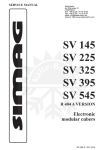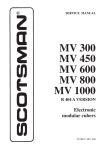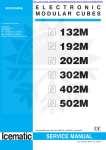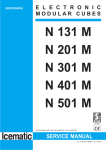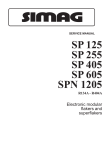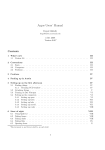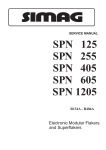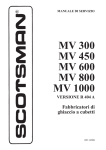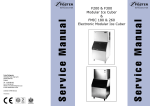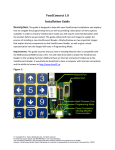Download Service Manual 10-2004
Transcript
Page 1 Page 1 SERVICE MANUAL SV 135 SV 215 SV 315 SV 535 R 404 A VERSION Electronic modular cubers MS 1000.78 REV. 10/04 Page 2 Page 2 TABLE OF CONTENTS Table of contents Specifications FOR THE INSTALLER Introduction Storage bin Standard legs Important operating requirements Select location Storage bin Ice machine Stacking instructions Final check list FOR THE PLUMBER Conform to all applicable codes Water inlet Drains For the electrician Electrical connections 2 3-4-5-6-7-8-9-10 11 11 11 11 12 12 12 12 14 13 13 13 START-UP Start-up cycle Freezing cycle Harvest cycle 15 15 15 OPERATION Refrigeration during freeze Water system Refrigeration system during harvest Water system Control sequence Alarm conditions PC Board set up 17 18 19 19 19 20 20 SERVICE SPECIFICATIONS Component Operating characteristics 22 22 COMPONENT DESCRIPTION Component description 23 WIRING DIAGRAM SV 135-215-315-535 air/water cooled 26 SERVICE DIAGNOSIS Service diagnosis 27 MAINTENANCE & CLEANING INSTRUCTION Icemaker Ice storage bin Cabinet erxterior Cleaning (Icemaker) 28 28 28 28-29 Page 3 Page 3 SPECIFICATIONS MODULAR CUBER SV 135 ice making capacity Kg. 10 130 21 110 32 90 38 70 32 27 21 15 WATER TEMPERATURE 10 °C ICE PRODUCED PER 24 HRS 130 °C AMBIENT TEMPERATURE ICE PRODUCED PER 24 HRS Kg. 140 WATER COOLED MODELS °C 10 21 120 32 110 38 100 90 32 27 21 15 AMBIENT TEMPERATURE AIR COOLED MODELS 10 °C WATER TEMPERATURE NOTE. To keep your Modular cuber performing at its maximum capacity, it is necessary to perform periodic maintenance as outlined on page 28 of this manual. Page 4 Page 4 SPECIFICATIONS (CONT'D) AIR COOLED CORD SET 3/4” GAS WATER INLET WATER OUTLET WATER COOLED Accessoires KSC 300 - Cube stacking kit Dimensions: HEIGHT WIDTH DEPTH WEIGHT 3/4” WATER INLET WATER COOLED ONLY 3/4” WATER DRAIN WATER COOLED ONLY 575 mm. (22" 1/2) 560 mm. (22") 620 mm. (24" 1/2) 55 Kgs. SV 135 - MACHINE SPECIFICATIONS Model SV 135 - AS SV 135 - WS Model SV 135 - AS SV 135 - WS Finish Comp. HP Water req. lt/24 HR Stainless Steel 3/4 300* 1500* Cond. unit Air Water Basic electr. amps Start amps watts Electric power cons. Kwhx24 HR. N. of wires Amps Fuse 220-240/50/1 3,8 3,3 18 780 650 18.7 15.6 3x1,5 mm2 10 Cubes per harvest: 132 Full - 264 Half * With water at 15°C Page 5 Page 5 SPECIFICATIONS MODULAR CUBER SV 215 ice making capacity AIR COOLED MODELS WATER COOLED MODELS °C Kg. 180 160 32 140 38 120 32 27 21 15 WATER TEMPERATURE 10 °C 200 10 21 180 32 38 160 140 AMBIENT TEMPERATURE 21 200 ICE PRODUCED PER 24 HRS. 220 10 AMBIENT TEMPERATURE ICE PRODUCED PER 24 HRS. °C Kg. 220 120 32 27 21 15 10 °C WATER TEMPERATURE NOTE. To keep your Modular cuber performing at its maximum capacity, it is necessary to perform periodic maintenance as outlined on page 28 of this manual. Page 6 Page 6 SPECIFICATIONS (CONT'D) AIR COOLED CORD SET 3/4” GAS WATER INLET WATER OUTLET WATER COOLED Accessoires KSC 450 - Cube stacking kit Dimensions: HEIGHT WIDTH DEPTH WEIGHT 3/4” WATER INLET WATER COOLED ONLY 3/4” WATER DRAIN WATER COOLED ONLY 575 mm. (22" 1/2) 760 mm. (30") 620 mm. (24" 1/2) 77 Kgs. SV 215 - MACHINE SPECIFICATIONS Model SV 215 - AS SV 215 - WS Model SV 215 - AS SV 215 - WS Finish Comp. HP Water req. lt/24 HR Stainless Steel 7/8 340* 1900* Cond. unit Air Water Basic electr. amps Start amps watts Electric power cons. Kwhx24 HR. N. of wires Amps Fuse 220-240/50/1 6 5 29 1000 900 24.0 21.6 3x1,5 mm2 16 Cubes per harvest: 204 Full - 408 Half * With water at 15°C Page 7 Page 7 SPECIFICATIONS MODULAR CUBER SV 315 ice making capacity WATER COOLED MODELS Kg. 10 300 290 21 260 230 32 200 38 170 32 27 21 15 WATER TEMPERATURE 10 °C °C 280 10 21 260 32 38 240 220 AMBIENT TEMPERATURE °C ICE PRODUCED PER 24 HRS. Kg. 320 AMBIENT TEMPERATURE ICE PRODUCED PER 24 HRS. AIR COOLED MODELS 200 32 27 21 15 10 °C WATER TEMPERATURE NOTE. To keep your Modular cuber performing at its maximum capacity, it is necessary to perform periodic maintenance as outlined on page 28 of this manual. Page 8 Page 8 SPECIFICATIONS (CONT'D) AIR COOLED CORD SET 3/4” GAS WATER INLET WATER OUTLET WATER COOLED Accessoires KSC 450 - Cube stacking kit Dimensions: HEIGHT WIDTH DEPTH WEIGHT 3/4” WATER INLET WATER COOLED ONLY 3/4” WATER DRAIN WATER COOLED ONLY 575 mm. (22" 1/2) 760 mm. (30") 620 mm. (24" 1/2) 77 Kgs. SV 315 - MACHINE SPECIFICATIONS Model SV 315 - AS SV 315 - WS Model SV 315 - AS SV 315 - WS Cond. unit Air Water Finish Comp. HP Stainless Steel 1 1/2 Water req. lt/24 HR 470* 2750* Basic electr. amps Start amps watts Electric power cons. Kwhx24 HR. N. of wires Amps Fuse 220-240/50/1 10 7.5 31 1600 1300 38.4 31.2 3x1,5 mm2 16 Cubes per harvest: 204 Full - 408 Half * With water at 15°C Page 9 Page 9 SPECIFICATIONS MODULAR CUBER SV 535 ice making capacity AIR COOLED MODELS °C Kg. 500 32 350 38 300 27 21 15 WATER TEMPERATURE 10 °C 10 21 32 38 450 400 350 300 32 27 21 15 10 °C WATER TEMPERATURE NOTE. To keep your Modular cuber performing at its maximum capacity, it is necessary to perform periodic maintenance as outlined on page 28 of this manual. AMBIENT TEMPERATURE 400 ICE PRODUCED PER 24 HRS. 21 450 32 °C Kg. 500 10 AMBIENT TEMPERATURE ICE PRODUCED PER 24 HRS. WATER COOLED MODELS Page 10 Page 10 SPECIFICATIONS (CONT'D) AIR COOLED CORD SET 3/4” GAS WATER INLET WATER OUTLET WATER COOLED Accessoires KSC 1000 - Cube stacking kit Dimensions: HEIGHT WIDTH DEPTH WEIGHT 3/4” WATER INLET WATER COOLED ONLY 800 mm. (22" 1/2) 760 mm. (30") 620 mm. (24" 1/2) 104 Kgs. 3/4” WATER DRAIN WATER COOLED ONLY SV 535 - MACHINE SPECIFICATIONS Model SV 535 - AS SV 535 - WS Model SV 535 - AS SV 535 - WS Cond. unit Air Water Finish Comp. HP Stainless Steel 2.5 Water req. lt/24 HR 700* 3500* Basic electr. amps Start amps watts Electric power cons. Kwhx24 HR. N. of wires Amps Fuse 380-400/50/3 5.5 14 2500 2100 60.0 50.4 5x1,5 mm2 10 Cubes per harvest: 340 Full - 680 Half * With water at 15°C Page 11 Page 11 FOR THE INSTALLER INSTALLATION NOTE: Allow 15 cm. minimum space at sides and back for ventilation and utility connections. INTRODUCTION These instructions provide the specifications and the step-by-step procedures for the installation, start up and operation for the SIMAG Model SV 135-215-315-535 Modular Cubers. The Models SV 135-215-315-53 Modular Cubers are quality designed, engineering and constructed, and are thoroughly tested icemaking systems, providing the utmost in flexibility to fit the needs of a particular user. STORAGE BIN The SV 135 stack on top of Simag bin model R 85; the SV 125-315-535 stack onto SIMAG bin model R 155. Refrigerant R 404 A Charge per nameplate rating. STANDARD LEGS: Furnished with storage bin. Four legs screw into mounting sockets on cabinet base. Provide 18.5 cm. (7’’) minimum height including adjustable leveling foot. Optional Kit Casters for R 155 (KRB 550) are available on request. IMPORTANT OPERATING REQUIREMENTS MINIMUM MAXIMUM Air Temperature 10°C (50°F) 40°C (100°F) Water Temperature 5°C (40°F) 35°C (90°F)0 Water Pressures 1 bar gauge 5 bar gauge -10% +10% Electrical Voltage Variations Voltage rating specified on nameplate Extended periods of operation exceeding these limitations constitues misuse under the terms of Manufacturer’s Limited Warranty, resulting in a loss of warranty coverage. Page 12 SELECT LOCATION The first step in installing the equipment is to select the location. The purchaser of the unit will have a desired spot in mind, check out that spot to insure that it is: - indoors, in an environment that does not exceed the air and water temperature limitations for the equipment. - that the necessary utilities are available including the correct voltage electrical power. - that there be space around the installed machine for service, 15 cm. minimum left, right, and rear for air-cooled models. Page 12 Remove first the ice deflector/evaporator cover then the masking tape from the ice thickness sensor. STORAGE BIN The SIMAG bins for these units are the R 85, R 155 and R 255. Other bins may be available with bin tops to vary the storage capacity. Lay the bin on its back, using cardboard from the carton to support it, screw in the legs. Stand the bin upright, and correct any possible small tears in the machine mounting gasket with food grade silicone sealant. ICE MACHINE The use of a mechanical lift is recommended for lifting the uncrated icemaker onto the bin. Remove front, top and sides panels. Place the unit directly onto the bin, align it with the back of the bin. Locate the hardware package, take out two mounting screws, and use them to secure the Icemaker to the two sides of the bin. See illustration below. SV 135 - AIR SEPARATOR Install on the back side of the machine the air baffle as per instruction provided with it. Remove all shipping material as well as the masking tapes from the ice deflector/evaporator cover. STACKING INSTALLATION To stack a second SV onto the present one, first remove the top panel from the lower machine. Add a bead of food grade silicone sealant to the top edges of the lower units freezing compartment. Lift the top machine onto the bottom Page 13 Page 13 machine, (the use of a mechanical lift is recommended for this step). Align the two machines cabinets, and using the 2 screw from the top units, hardware package, fasten the two units together at the side cabinets. Then make use of the Stacking Kit KSC 300, KSC 450 and KSC 1000, to be mounted as per fitting instructions included in their package, respectively on SV 135, SV 215-315 and SV 535 located in the bottom for proper conveying, of the ice cubes made by the top unit, into the storage bin. With food grade silicone perfectly seal the edge between the freezing compartment of the upper machine and of the bottom machine so to avoid any possible leak of water through the clearence in between. When choosing the water supply for the SV Cuber, consideration should be given to: A. Length of run. B. Water clarity and purity. C. Adequate water supply pressures. Since water is the most important single ingredient in producing ice you cannot over emphasize the three items listed above. Low water pressure, below 1 bar may cause malfunction, of the icemaker unit. Water containing excessive minerals will tend to produce cloudy colored ice cubes, plus scale build-up on parts in the water system. Heavily chlorinated water can be controlled using charcoal or carbon filters. DRAINS FOR THE PLUMBER CONFORM TO ALL APPLICABLE CODES WATER INLET AIR-COOLED MODELS: The recommended water supply is cold water connected to the - 3/4'’ gas - male fitting at the back of the cabinet. Install a hand valve near the machine to control the water supply. AIR-COOLED MODELS: There is one 20 mm. dia sump drain fitting at the back of the cabinet. Insulations in high humidity areas is recommended. The ideal drain receptacle would be a trapped and vented floor drain. WATER-COOLED MODELS: Besides the above drain, a separate condenser drain must be run. Connect it to the - 3/4'’ gas - condenser drain connection at the back of the cabinet. STORAGE BIN: A separate gravity type drain needs to be run, similar to the air-cooled sump drain. Insulation of this drain line is recommended. FOR THE ELECTRICIAN ELECTRICAL CONNECTIONS The unit come equipped with an electrical cord for power supply. The lead wires must be connected to an electrical plug that corresponds to the local electrical codes and requirements or to a separate two poles disconnect box with opening to the contacts of about 3 millimeters. The disconnect box shoulds be placed close to the selected ice maker location to be easily and prompt reached. Undersized wiring or unproperly installed electrical circuit will result in major problems and malfunctions. Voltage variations shoud not exceed ten percent. 1) Switch 2) Plug receptacle 3) Electrical plug 4) Water inlet 5) Shut-off valve 6) Water filter 7) Water outlet line 8) Bin water outlet line 9) Open vented water drain 10) Water outlet from the condenser: water cooled version only. IMPORTANT - All plumbing and electrical connections must be made by licensed plumbers and electricians, this one must follow the electrical specifications printed on the ice maker nameplate. NOTE: All SIMAG Cubers require a neutral wire and a solid earth ground wire to prevent possible severe Electrical Shock Injury to individuals or extensive damage to equipments. Page 14 Page 14 7. Have the compressor holddown bolts been checked to be sure the compressor is snug on the mounting pads. FINAL CHECK LIST 1. Is the cabinet/bin level? 2. Is the cuber in a location where ambient temperatures are a minimum of 10°C (50-degrees F.) all year around and to not exceed a maximum of 40°C. (100°F.). 3. Is there at least a 15 cm. clearance behind and around the cabinet for all connections and for proper air circulation? 4. Have all electrical and piping connections been made? 5. Has the electrical power supply wiring been properly connected and the voltage tested and checked against the nameplate rating? Has the unit properly grounded. 6. Is the water supply line shutoff valve installed and opened and has the inlet water supply pressure been checked to insure a minimum of 1 bar without exceeding a maximum of 5 bar. 8. Check all refrigerant lines and conduit lines to gard against vibration and possible failure. 9. Has the cuber and the bin been wiped clean with clean damp cloths? 10. Has the owner/user been given the User Manual and instructed on how to operate the icemaker and the importance of periodic maintenance? 11. Has the owner/user been given the name and telephone number of the Authorized SIMAG Distributor or Service Agency serving him? 12. Has the Manufacturer’s Registration Card been properly filled out? Check for correct Model and Serial Numbers from nameplate, then mail the completed card to the Manufactured. TYPICAL STACKING INSTALLATION KIT STACKING KSC 300: TO STACK 2 SV 135's KIT STACKING KSC 450: TO STACK 2 SV 215-315's KIT STACKING KSC 1000: TO STACK 2 SV 535's Page 15 Page 15 START-UP 3. Water is coming into the water through the Water Inlet Solenoid Valve till the water reservoir if filled up to the maximum level controlled by a Water Level Sensor. START-UP CYCLE 1. Open the water tap/valve and switch ON the power on the electrical supply line. 2. The machine enter in the Start Up mode with the PC Board energized as well as the Green LED of the machine under power. POWER OPER. BIN FULL ALARM ALARM HI PRESS. RE-SET The Green LED of machine in operation is energized too, blinking fast for 40 seconds. 3. During the Start Up cycle the components in operation are: • Hot gas valve • Water Drain Valve • Water Pump FREEZING CYCLE 1. After the Start Up cycle the machine enters directly into the Freezing cycle with the following components energized: • Water Inlet valve • Compressor • Fan motor (in continuous operation for the first 3 minutes). 2. The LED energized are: • Machine under power • Machine in operation (steady) 4. 30 seconds later, the Water Pump starts up. 5. After 3 minutes from the start up of the freezing cycle, the Water Inlet Solenoid Valve is activated again for few seconds till the water reaches the maximum level so to reduce any possibility of slush ice formation. 6. In the meantime the condenser sensor starts to transmit the current to the PC Board keeping in operation the Fan Motor in ON-OFF mode or continuously according to the condenser temperature. NOTE: Do not remove the evaporator deflector cover as it will cause the switching off of the machine at "STORAGE BIN FULL". 7. The machine remains in the freezing cycle with the ice that become thicker till the two metal plates of the Ice Thickness Sensor are covered by the water cascading through the front surface of the ice plate. 8. When the Power is transmitted back to the PC Board continuously through the metal plates of the Ice Thickness Sensor for more then 6", the machine enters in the Pre-Harvest or directly into the Harvest Cycle mode according to: • FAN MOTOR IN ON-OFF MODE DURING THE PREVIOUS FREEZING CYCLE RISE UP THE CUT IN TEMPERATURE OF THE CONDENSER SENSOR TO 38°C (FAN MOTOR OFF) AND EXTEND THE LENGTH OF FREEZING CYCLE BY 30" MORE THEN GO INTO HARVEST CYCLE • FAN MOTOR ALWAYS IN OPERATION DURING THE PREVIOUS FREEZING CYCLE GO STRAIGHT TO THE HARVEST CYCLE 9. First freezing time will range between 15 and 20 minutes. Longer time for temperature above 25°C and shorter time required when temperature are below 25°C. Average complete cycle time is about 22 min. HARVEST CYCLE 1. During the harvest cycle the components in operation are: • Hot Gas valve • Water Drain/Purge Valve • Water Pump for the first 40" • Compressor Page 16 and both • Machine Under Power • Machine in Operation 2. 30 seconds after the beginning of the Harvest Cycle, the Water Inlet Solenoid Valve is energized for 10 seconds only in order to have a short flush of fresh water into the sump while the Water Pump is still in operation. 3. The Fan Motor remains in OFF mode unless the Condenser Sensor probe rise up to more then 38°C (same set up as per end of freezing cycle). 4. When the ice plate is falling down from the evaporator, the magnetic switch is activated for a while providing the signal to the PC Board to restart a new freezing cycle. 5. Observe first ice cube harvest and check size of ice cubes; if an adjustment is required thread down or out screw N. 1 as shown on below illustration. Page 16 NOTE: This type of machine produce an "ICE PLATE" that breaks when falls down into the storage bin. Setting the ice thickness sensor in order to have single ice cubes may cause malfunction of the machine. 6. Observe second and third cube harvest. Check if size and shape combination is correct. In areas where extreme problem water conditions exist, filtering or purifyng equipment is recommended. NOTE: If water used is too soft, "demineralized" the ice thickness sensor might not be able to sense the water on its reeds, there by it will not switch the unit on harvest cycle. A safety system built in the P.C. Board switches the unit on harvest cycle whenever the freezing period gets longer then 30' or 40'. NOTE: To assure a correct operation of the machine the water must have a minimum electrical conductivity of 20 us. 7. Check operation of magnetic switch controlling it by keeping open the bottom end of plastic deflector for more than 30 seconds. The machine must switch off at storage bin full. Release the plastic deflector. The machine should restart in the freezing cycle mode within few seconds going through a 3' delay time. 8. Place again all cabinet panels and screws previously removed. This screw position determines the distance between the sensor reeds and the egg-crate evaporator thus keeping the ice cube at a proper thickness. 9. Thoroughly explain to owner/user the significant specifications of the ice maker start-up, reset and operation, going through the procedures in the operating instructions. Answer all questions about the ice maker by the owner and inform the owner himseft of the name and telephone number of the authorized service agency serving him. Page 17 Page 17 OPERATION FREEZE CYCLE REFRIGERATION SYSTEM SCHEMATIC REFRIGERATION DURING FREEZE: This ice machine employes either air or water as a condensing media, the refrigeration system for either one is a follows: At the hermetic compressor, Refrigerant is compressed into a high temperature, high pressure gas. The gas moves through the discharge line into the condenser, air or water-cooled. If air-cooled, the discharge pressure will change with the heat load and the ambient air temperature. If water-cooled, the discharge pressure is controlled by the amount of water flowing through the condenser - which is determined by the water regulating valve. After the gas is cooled in the condenser, giving up much of its heat, the gas condenses into a high pressure liquid. This liquid travels through the liquid line to the metering device, a thermostatic expansion valve. The thermostatic expansion valve meters how much liquid refrigerant is to be allowed into the evaporator section of the refrigeration system. This is determined by the temperature of the TXV sensing bulb, located on the suction line manifold, at the outlet of the evaporator. If the bulb senses a warm suction line, more refrigerant is allowed into the evaporator, (common at the beginning of the freeze cycle) and when the temperature begins to fall, less refrigerant is allowed through. This is why the suction side gauge pressure will decline throughout the freeze cycle. At the evaporator, the liquid refrigerant released from high pressure, boils off in the low pressure environment and absorbs heat, thus cooling the evaporator surface and anything near it, such as water. The low pressure refrigerant vapor then is forced through the heat exchanger where any excess liquid refrigerant boils-off, allowing only refrigerant vapor to enter the compressor suction tube, where it is recompressed into high pressure, high temperature gas again and the cycle repeats. Page 18 Page 18 FREEZE CYCLE WATER SYSTEM A combination of a solenoid water inlet valve with a water level sensor is used to control the level of the water into the reservoir/sump. A pump, running continuously, after the first 30" of freezing cycle, forces the water to the top of the evaporator, where it is distributed through a WATER SPRAY TUBE water tube and then cascades down the evaporator surface by gravity. As it flows accross the refrigerated evaporator, some of the water will be chilled enough to change form, turn to ice, and stay frozen onto the evaporator cells. Most of the water returns to the reservoir, to be sucked back into the pump, and repumped over the evaporator. PURGE VALVE WATER INLET VALVE WATER PUMP WATER LEVEL SENSOR Page 19 Page 19 HARVEST (DEFROST) CYCLE REFRIGERATION SYSTEM SCHEMATIC REFRIGERATION SYSTEM DURING HARVEST The refrigeration system performs the harvest of ice by use of a hot gas bypass valve. When the time comes to de-ice the evaporators, the hot gas valve is energized, and the high temperature, high pressure gas bypasses the condenser, and is allowed directly into the evaporator. The high pressure gas is cooled by the cold evaporator so it condenses into a liquid, giving up its heat as it does so. This heat warms the evaporator and the ice frozen onto the evaporator surface melts, releasing the frozen cubes. Ice then falls by gravity into the storage bin. The liquid refrigerant goes through the suction line into the heat exchanger where it boils-off so that only refrigerant vapor is drawn into the suction tube of the compressor. WATER SYSTEM During the harvest cycle, the electric water drain valve is energized thereby opening the drain line. All water remained in the reservoir at the end of freezing cycle is pumped-out, to the waste, through the water solenoid and drain line during the first 40 seconds of the defrost cycle eliminating any possible build-up and accumulation of minerals concentration and impurities in the water reservoir. The water inlet valve is energized during the last 10" of the operation of the water pump so to rinse the water tank with new fresh water. When the released ice cubes drop into the bin, they open-up for a fraction of a seconds the bottom end of plastic deflector. This deflector swinging motion is enough to reset the contact of the magnetic switch which - via electronic control board - deenergizes the water drain valve allowing the unit to initiate a new freezing cycle. The harvest cycle lasts about 1.5÷2 minutes. CONTROL SEQUENCE At the start of the freezing cycle, the contacts of the magnetic switch mechanically operated by Page 20 POWER the actuator plate of the deflector cover are closed, thereby - via electronic control board closing the circuit to the main contactor coil and consequently to the compressor and fan motors and 30" later, to the water pump motors. Then, as the ice thickness reaches the value that corresponds to the full cube size, the film of water that constantly cascades over the slab of ice formed on the evaporator, arrives to establish a contact between the two fingers (energised at low voltage) of the ice sensor control, located on the front upper right side of the evaporator. If the contact between the two fingers of the ice sensor remains established - by the film of water - for more than 10 seconds, a small relay of the electronic board, get energized, controlling simultaneously both the hot gas valve and the water drain valve. NOTE: in case of failure of ice level sensor, the P.C. Board turns - on automatically the unit into the defrost cycle when the freezing cycle reaches 30 or 40 minutes according to the operation of the fan motor during the freezing cycle. At this point, the unit initiates the defrost cycle. The hot gas circulating into the evaporator serpentine causes a slight melting of ice cubes which get released from their molds. Once entirely released the ice cubes drop simultaneously into the ice storage bin below; by doing so they move apart from the evaporator bottom end the plastic deflector. This plastic deflector has on its side a magnetic switch that on account of the deflector swinging motion, caused by the ice while dropping in the bin, opens and closes their contacts. This will, in turn, disactivate the relay contacts that controls the hot gas and water drain valve which get deenergized allowing the unit to start a new freezing cycle. When the ice bin is full of ice, the last batch of ice cubes released from the evaporator accumulates to keep the bottom end of the plastic deflector in open position; with the magnetic switch contacts open for longer than 30'’ the entire unit stops with the glowing of the corresponding LED. The machine will restart when the ice deflector will be back in its normal vertical position provided that 3' are elapsed from unit stop. If not the machine will delay its restart till 3' are elapsed with the blinking of the green LED. ALARM CONDITIONS POWER OPER. BIN FULL ALARM ALARM HI PRESS. OPER. BIN FULL Page Page20 20 ALARM ALARM HI PRESS. RE-SET Both the last two Red LED are BLINKING SLOW: WATER ERROR Water level inside the water sump too low after 3' from the activation of the Water Inlet Valve. Both the last two Red LED are BLINKING FAST: RESET MODE: Charging water through the Water inlet Solenoid Valve after the tripping OFF on WATER ERROR POWER OPER. BIN FULL ALARM ALARM HI PRESS. RE-SET The fourth Red LED is ON STEADY: Harvest Cycle longer then 3' 30" The fourth Red LED is BLINKING SLOW: TOO HI CONDENSING TEMPERATURE. The condenser sensor detected a temperature > 65°C The fourth Red LED is BLINKING FAST: RESET MODE: Condenser Sensor < 50°C Fan motor in operation for 3' then back on Start Up Cycle Mode POWER OPER. BIN FULL ALARM ALARM HI PRESS. RE-SET The fifth Red LED is ON STEADY: TOO HI DISCHARGE PRESSURE > 33 bar 460 PSI The fifth Red LED is BLINKING FAST: RESET MODE: After pushing the Reset Button of the Pressure Control first the fan motor starts up for 3' then back on the Start Up Cycle Mode. The PC Board is also checking the maximum time of the freezing cycle that changes according to the operation of the fan motor during the freezing cycle (room temperature): • Fan motor in ON-OFF mode: Max. freezing cycle length equal to 30' • Fan motor ON All the time: Max. freezing cycle length equal to 40' RE-SET Both the last two Red LED are ON STEADY: Condenser Sensor OUT OF ORDER. Whenever the machine remains in the Freezing Cycle for the Maximum time (30 or 40 minutes), the PC Board moves the unit directly into the Harvest Cycle. Page 21 Page 21 PC BOARD SET UP The PC Board can be set up for: AUTOMATIC RESET MODE • Manual Reset Mode (Jump IN) The Automatic Reset Mode is activated only for the following ALARM CONDITIONS: • WATER ERROR • TOO HIGH CONDENSING TEMPERATURE • TOO LONG HARVEST CYCLE WATER ERROR The machine remains in OFF mode for 30' then it tries to re-fill water: YES: Machine remains in operation NO: Machine again in OFF mode for additional 30' • Automatic Reset Mode (Jump OUT) TOO HI CONDENSING TEMPERATURE: As soon as the temperature of the Condenser Sensor is < 50°C, the PC Board starts up first the fan motor for 3' then the entire machine through the Start-Up Cycle Mode. TOO LONG HARVEST CYCLE: After the 3' 30" of the Harvest Cycle, the PC Board move back the machine into a new Freezing Cycle. MANUAL RESET MODE To Restart the machine it is necessary to Push the RESET BUTTON Page 22 Page 22 SERVICE SPECIFICATION In servicing a machine, it is often, useful to compare that individual units operating characteristics to those of a normally operating machine. The data that follows gives those characteristics; however, be aware that these values are for NEW, CLEAN machine operating at 21 °C ambient and 15 °C water. USE THESE NUMBERS AS A GUIDELINE ONLY. COMPONENT Reservoir level ............................80 ÷ 85 mm Cube Size Control Ice Sensor - distance from evaporator .........................................3 ÷ 5 mm OPERATING CHARACTERISTICS On air-cooled models during the freezing cycle, the discharge pressure is maintained between two preset values by means of fan control (condenser sensor); and at the same time, the suction pressure will also decline reaching it’s lowest point just before harvest. Compressor amps experience a similar drop. On water-cooled, the discharge pressure is constantly, maintained during the freeze cycle by the water regulating valve. However, suction pressure and compressor amps, will still decline as the machine freezes ice. High Pressure Safety Switch. SV 135: Cut IN 19 bar - Cut OUT 30 bar SV 215-315-535: Cut IN 23 bar - Cut OUT 33 bar Disch. Pressure Freeze max Disch. Pressure Freeze min Hi Pressure CUT OUT Suction Pressure Beginning Freeze Suction Pressure end Freeze Freezing time SV 135 A 17,5 bar 14,0 bar 30 bar 4,3 bar 2,3 bar 15' 3,8 3,2 SV 135 W 16,5 bar 16,5 bar 30 bar 4,3 bar 2,4 bar 16' 3,6 3,1 SV 215 A 17,0 bar 15,0 bar 33 bar 3,6 bar 2,3 bar 16' 4,2 3,4 SV 215 W 16,2 bar 16,0 bar 33 bar 3,8 bar 2,5 bar 16' 3,9 3,3 SV 315 A 18,0 bar 16,0 bar 33 bar 2,9 bar 1,7 bar 11' 7,0 5,2 SV 315 W 16,5 bar 16,0 bar 33 bar 2,9 bar 1,7 bar 11' 6,5 5,2 SV 535 A 18,0 bar 15,5 bar 33 bar 3,2 bar 1,7 bar 12,5' 4,0 3,1 SV 535 W 16,5 bar 16,5 bar 33 bar 3,2 bar 1,9 bar 13' 3,5 2,7 MODEL Amps Amps Compressor Compressor Beginning end Freeze Freeze Refrigerant charge R 404 A MODEL SV 135 SV 215 SV 315 SV 535 Air cooled 500 700 850 1600 Water cooled 400 500 550 1200 Refrigerant metering device Thermostatic expansion valve. NOTE: Always check nameplate on individual icemachine for special refrigerant charge before charging the refrigeration system. Such refrigerant charge is the average charge for the SV Modular Cubers. However it is important to check nameplate for each machine. Page 23 Page 23 COMPONENT DESCRIPTION 1. LED Nr. 5 Alarm high pressure. BUTTON B Reset/Washing. Front Console Panel Equipped with five LED plus a push button that when glow or blink are monitoring: LED Nr. 1 Electrical power supply. LED Nr. 2 Operation. LED Nr. 3 Bin full./Washing. LED Nr. 4 Alarm. SV SERIES FAN MOTORS PC BOARD COMPRESSOR, HOT GAS, WATER INLET AND DRAIN VALVES POWER IN AND SAFETY PRESSURE CONTROLS WATER PUMP N.O. - JUMP OUT AUTOMATIC N.C. - JUMP IN MANUAL FUSE - J2 + WATER SENSITIVITY ADJUSTMENT J1 FOR FACTORY USE ONLY SERIAL CONNECTOR DISPLAY CONNECTOR ICE THICKNESS SENSOR WATER LEVEL SENSOR 2. P.C. Board Located in the control box, this board is the brain of the system as it governs the ice machine cyclematic through sensors, relays and switch. It consists of two separated printed circuits one at high and the other at low voltage integrated with a fuse, of four connectors for the sensors/switches (condenser sensor - BLACK -, magnetic switch - GREEN - ice thickness sensor - RED - water level sensor - BLUE), of two jumpers (one J1 for factory use only - and the second J2 for the selection between manual or automatic reset mode), of one outlet connector (front LED display - black) one serial port connector (black) and of four plug in terminals for input and output power. With J2 closed the P.C. Board is set up for Manual reset mode. When J2 is open on MAGNETIC SWITCH CONDENSER SENSOR Automatic Reset mode. The P.C. Board is equipped by an electronic safety timer that turns-on automatically the unit to defrost cycle when freezing cycle is longer then 30 or 40 minutes and trips-off completely unit when defrost cycle is longer then 3,5 minutes (4th Red LED ON). A trimmer, located close to the transformer, can change the current received back from the Ice Tickness Sensor according to the Electrical Conductivity of the water. 3. Compressor Contactor Located in the control box, the compressor contactor functions to carry the compressor line current. The contactor is wired to receive power from the P.C. Board. Page 24 Page 24 4. Ice Thickness Sensor Located in the front upper right side off the evaporator, the sensor is made with two metal reeds in which passes power at low voltage. The two metal reeds, which are individually insulated, are set, through a setting screw, to maintain a minimum clearence from the evaporator (3÷5 mm). Once ice is formed into each mold and is thick enough to fill-up that minimum clearance existing between the two sensor reeds and the evaporator, the water that cascades over the ice has gradually approached to make contact between the two sensor reeds. It is enough that this contact remains there for about 10 seconds that the P.C. Board receives the signals to put the ice machine on defrost. 5. Magnetic Switch Located in the front of the evaporator plastic curtain, this switch sends a pulse to the P.C. Board which switches the machine back in the freezing cycle. 6. Hot Gas Solenoid Valve The Hot Gas Solenoid Valve functions only during the Harvest Cycle, to divert the hot discharge gas from the Compressor, bypassing the Condendenser and thermostatic expansion valve, for direct flow to the Evaporator Platen Assembly to release ice cubes from the ice cube molds. The Hot Gas Solenoid Valve is comprised of two parts, the Body & Plunger and the Coil assembles. Installed in the discharge line of the Compressor, the energized solenoid coil lifts the valve stem within the valve body to cause the hot discarge gas to be diverted when the ice Thickness sensor has signalled to the P.C. Board to start the Harvest Cycle. 7. Condenser temperature sensor The condenser temperature sensor probe (located in contact with the condenser tube coil) detects the condenser temperature variations and signals them by supplying current, at low voltage, to the P.C. BOARD. In the air cooled versions, in relation to the different current received, the micro processor of the P.C. BOARD supplies, through a TRIAC, the power at high voltage to the fan motor so to cool the condenser and to reduce its temperature. In case the condenser temperature rises and reaches 65°C (150°F) the current arriving to the micro processor is such to cause an immediate and total stop of the machine operation with the blinking of the Red LED. 8. High Pressure Control The high Pressure Control, a safety control, is factory set to cut-out, at 30 bar and cut-in at 22 bar. The control, functions as a precautionary device to shut OFF electrical power to Icemaker, should a loss of water occur to the water cooled Condenser or a burnt out of the fan motor on air cooled versions. The high Pressure Control is manual reset with reset button located on the rear side of the machine and a monitoring light on the Front Console Panel. 9. Water Regulating Valve (Water Cooled Models) The Water Regulating Valve functions maintain a constant Compressor head pressure, by regulating the amount of incoming water flow through the Condenser, on water-cooled models. The valve operate through the refrigerant system high side pressure. Rotating the adjusting screw located on top of the valve, can INCREASE or DECREASE the water flow through the watercooled Condenser, which in turn, will DECREASE or INREASE the Compressor operating head pressure. 10. Water Distribution System The Water Distribution System function to eventy supply water to all cells of the evaporator plate. The water pump pumps water from the sump to the tee. From there water is channeled through the vertical tygon tube to the water distributors, above the evaporator plate, and from the holes in the distributor tube water flows to the cells on one side of the evaporator plate. Gravity flow returns the unfrozen excess portion of water to the sump reservoir for recirculation. 11. Water Drain Solenoid Valve The Water Outlet Solenoid Valve functions in conjunction with the water pump to flush-out the sump assembly at the beginning (first 40") of every harvest cycle. This action cleans-up and rinses the sump during each harvest cycle preventing dangerous water minerales concentration. 12. Thermostatic Expansion Valve The Thermostatic Expansion Valve regulates the flow of refrigerant to the evaporator and reduces pressure of liquid refrigerant from condensing pressure to evaporating pressure. 13. Water pump The water pump primes the water from the sump to the water distributor tube and through the distributing holes it cascades down onto the evaporator cells by gravity so to be frozen into clear ice cubes. The water pump remains off during the first 30" seconds of the freezing cycle (to avoid any cavitation problem) while it's kept running during the first 40" of defrost/harvest cycle to drain out (purge) the remaining water from the sump (reach in mineral salts). 14. Water inlet solenoid valve - 3/4" male fitting The Water Inlet Solenoid valve is energised by the P.C. Board during the beginning of the freezing cycle till the water reaches the maximum level into the sump (controlled by the Water Level Sensor). After 3 minutes, from the start up of the freezing cycle, the Water Inlet Valve is energised again for a short period to re-fill the sump with water till Page 25 again to the max. level so to minimise any possibility of slush ice formation A flow control, fitted into its outlet port, reduces the pressure of the water flow. 15. Water level sensor The Water Level Sensor, located on the upper right side of the water sump, works in conjunction with the P.C. Board in order to control the water Page 25 level at beginning of the freezing cycle by receiving a low power current passing through the water. When the current reaches the PC Board, the water inlet solenoid valve is de-energised. In case the PC Board doesn’t receive any signal (current) from the Water Level Sensor within the first 3 minutes of the freezing cycle, the PC Board trips OFF the operation of the machine with the switching ON of the Water Error LEDs. Page 26 Page 26 SV 135/215/315/535 - WIRING DIAGRAM 220 V. 50 Hz. 1 ph. m bc gv b n r a A B C D E F G H I J - Input terminal board Compressor contactor Compressor Ice sensor End defrosting switch Water level sensor Condenser temperature probe Led card PC Board Hi pressure switch KL MNOPQRC CS CM- = = = = = = = brown light blue yellow green white black red orange Manual/Automatic reset jumper Water pump Water inlet valve Water drain/purge valve Hot gas valve Fan Motor (only AIR cooled unit) Fan Motor (only WATER cooled unit) Compressor relay Start capacitor Run capacitor Page 27 Page 27 SERVICE DIAGNOSIS The table below is intended as a quick reference to aid the Service Agent in determining the cause of a particular type of malfunction, as well as the recommended repair. It is not intended to be an exclusive list. Reference to other portions of this manual, inclusing wiring diagrams, installation, and operation are recommended to better determine the cause of a problem. SYMPTOM POSSIBLE CAUSE CORRECTION Warning Red LED ON See page 20 See page 20 No warning LED/LIGHT ON P.C. Board inoperative. Remove board and check. No power to unit. Check electrical source. Bin Full of ice. Nome. Magnetic switch inoperative. Check and replace. P.C. Board compressor relay open. Test and replace. Compressor contactor open. Test and replace. Compressor relay open. Test and replace. Compressor winding open. Test and replace. Ice thickness control open. Check sensor fingers if are not covered with scale sediment. Too soft water. Water electrical conductivity must be higher then 20 µS. Machine can't run with demineralized water. Built-in relay on P.C. Board open. Check and replace P.C. Board. Machine runs, makes and harvests ice but very slowly. Low refrigerant charge. Check system for correct refr. charge. Check for leak weight in charge. Low ice capacity. High discharge pressure due to not-condensable or overcharge. Evacuate and weigh in charge. Inefficient compressor. Replace. Condenser dirty. Clean. Low water flow (Water-cooled). Check and repair. High air temperature (air-cooled). Check temperature of air entering condenser. Plugged water distributor. Clean water distributor. TXV supertheat wrong. Adjust or replace. Refrigerant charge low. Adjust-check for leak. recharge. Bin full Yellow LED ON Machine runs, compressor does not. Machine runs, makes ice, does not try to harvest. Machine makes irregular ice. Page 28 Page 28 MAINTENANCE & CLEANING & SANITATION INSTRUCTIONS A SIMAG Ice System represent a sizable investment of time and money in any company’s business. In order to receive the best return for that investment, in MUST receive periodic maintenance. It is the USER’S RESPONSIBILITY to see that preferable, and less costly in the long run, to avoid possible down time by keeping it clean, adjusting it as needed and by replacing worn parts before they can cause failure. The following is a list of recommended maintenance that will help keep your machine running with a minimum of problems. Maintenance and Cleaning should be scheduled at MINIMUM twice per year while sanitation once per month. 8. Check cube size, adjust if required through setting screw of ice thickness control sensor. 9. With unit out of operation, clean the condenser using vacuum, cleaner, wisk broom or brush. Instruct customer to clean condenser frequently DO NOT USE A WIRE BRUSH. ICE STORAGE BIN The interior liner of the bin is in contact with a food product, ice, and should be cleaned and sanitised regularly. Once a week sanitise it with a commercial food grade sanitiser compling with the manufacturer dilution. ICEMAKER THE FOLLOWING MAINTENANCE SHOULD BE SCHEDULED AT LEAST TWO TIMES PER YEAR ON THIS ICEMAKER. CALL YOUR AUTHORIZED SIMAG SERVICE AGENCY. 1. Check and clean or service any optional water treatment devices, if any installed. 2. CABINET EXTERIOR Wipe clean unit and bin cabinet exterior with a clean cloth or disposable paper wipers, soaked in warm water with mild detergent solution. CLEANING - Ice maker Clean water strainer. WARNING - Ice Machine Cleaner contains Phosphoric and Hydroxyacetic acids. These compounds are corrosive and may cause burns. If swallowed, DO NOT induce vomiting. Give large amounts of water or milk. Call physician immediately. In case of sxternal contact, flush with water. KEEP OUT OF THE REACH OF CHILDREN. 3. Check that the cabinet is level, in the sideto-side and front-to-back directions. 4. Clean/Sanitise the water system, evaporator plate and sump assembly, using a solution ot Ice Machine Cleaner/Sanitiser. Refer to CLEANING Icemaker. NOTE: Cleaning/Sanitising requirements vary according to local water conditions and individual user operation. Continuous check of the clarity of ice cubes and visual inspection of the water system parts, evaporator plates and the sump assembly before and after cleaning will indicate frequency and procedure to be followed in local areas. 5. Check and tighten all bolts and screws. 6. Check for water leaks and make corrections. 7. Check the bin control to test shut-off. Holding the evaporator deflector in open Position for more that 30", shold cause the ice maker to shut-off. Once the evaporator deflector is released in its closed position, the ice maker will restart. 1. Empty bin of ice. 2. Remove front panel. 3. Wait till the end of the defrost/harvest cycle then push the RESET BUTTON for 6-8 seconds. The machine should stop with the blinking of the Yellow LED (slow blink). 4. Pour on SV 135 150 cc and on SV 215-315535 250 cc of Simag Ice Machine Clea-ner directly into the reservoir then push again the RESET BUTTON for a while. The water pump starts to operate with the fast blinking of the Yellow LED while the water inlet valve will be energized till the fill up of the water sump. 5. After 15 minutes push the RESET BUTTON for a while. The P.C. Board put the machine in automatic rinsing mode with the special blinking (blink twice and repeat) of the Yellow LED. Page 29 NOTE: RINSING mode consists of: a) energize the water drain valve and the water pump for 40 seconds to empty the reservoir b) deenergize the water drain valve and the water pump for 1 minute c) energize the water inlet valve till the fill up of the water sump d) energize the water pump for 1,5 minutes. The above sequence is repeted 7 times so to be sure to have removed any possible trace of Ice Machine Cleaner. 6. At the end of the 7th Rinsing cycle the P.C. Board stops the operation of the machine with the blinking (slow) of the Yellow LED. Page 29 7. Pushing the RESET BUTTON for 6-8 seconds the machine restarts in the freezing cycle. 8. Replace the evaporator cover deflector and front panel. 9. Check the next batch of cubes to be sure all the cleaner is gone (no sour taste). CAUTION - DO NOT use ice cubes produced from the cleaning solution. Be sure none remains in the bin. 10. Pour hot water into the storage bin melt the cubes, and to also clean the bin drain. I C E M A C H I N E S www.simag.it SIMAG via Risorgimento, 4 20017 Mazzo di Rho (MI) - Italy Tel. +39 02 93900215 (Commerciale - Sales Dept.) Tel. +39 02 93546226 (Assistenza - Service Dept.) Fax +39 02 93900226 (Commerciale - Sales Dept.) Fax +39 02 93546231 (Assistenza - Service Dept.) e-mail: [email protected] e-mail: [email protected] Certified ISO 9001 TOTAL QUALITY Singapore Office SIMAG FAR EAST 627A Aljunied Road 04-04 Biztech Centre Singapore 389842 Tel. ++65 6738 5393 Fax ++65 6738 1959 e-mail: [email protected]






























